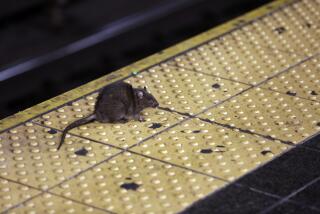Pregnant Rats in Space Face Births on Earth
- Share via
KENNEDY SPACE CENTER, Fla. — Biologists are pacing back and forth, awaiting the birth of more than 300 rats as shuttle Atlantis soars overhead with the first pregnant mammals to fly aboard a U.S. spacecraft.
The 10 pregnant rats--and 20 others in a NASA laboratory in Florida--are part of an experiment to see how weightlessness affects fetal development.
“People are kind of walking the floors like expectant fathers,” Hubert Burden, a professor of anatomy and cell biology at East Carolina University in Greenville, N.C., said Tuesday. “We’re quite anxious. We don’t know what’s going to happen.”
Scientists will have to wait until next week to find out. None of the rats are supposed to give birth until after Atlantis returns to Earth on Monday.
Each rat has at least 10 fetuses. Female rats have two wombs. Burden and other researchers will deliver the babies by Cesarean section from one womb of each space rat shortly after landing; the mothers should give birth naturally two days later from the other womb.
The ground rats will give birth about the same time, the same way, for comparison.
All the animals will eventually be killed for dissection.
Joe Tanner, one of Atlantis’ six astronauts, said Tuesday that during the first four days of the 11-day ozone-studying mission, the rats “would huddle together and be very quiet, not moving around very much, kind of the way I wanted to be for the first couple days.”
By Monday, day No. 5, “they were moving around and grooming themselves and looked to be very happy and very healthy,” Tanner said. That’s about how long it took Tanner, a first-time space flier, to adjust to weightlessness.
Two-thirds of all astronauts suffer motion sickness during their first few days in orbit.
More to Read
Sign up for Essential California
The most important California stories and recommendations in your inbox every morning.
You may occasionally receive promotional content from the Los Angeles Times.













